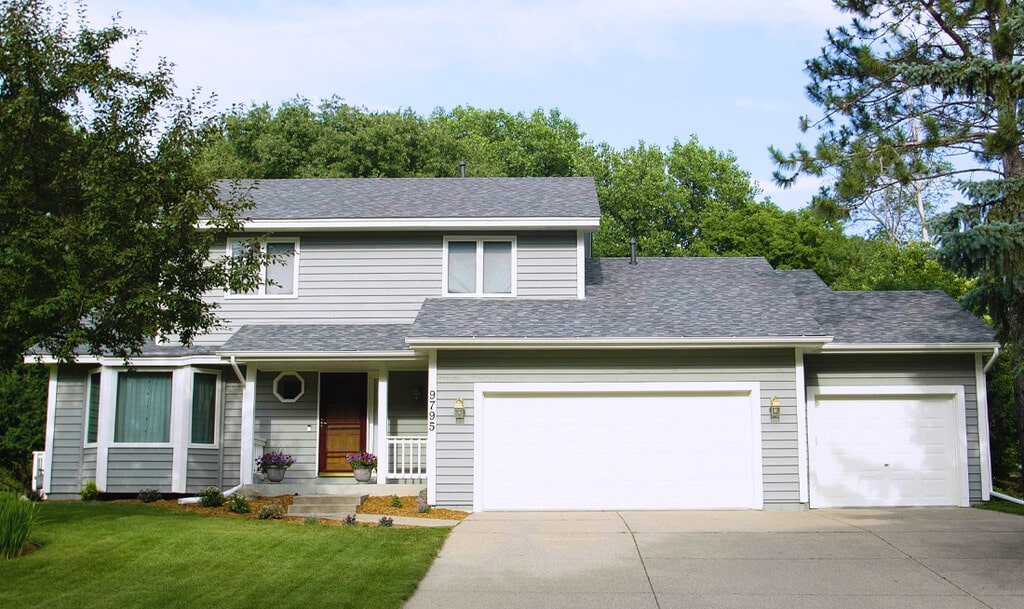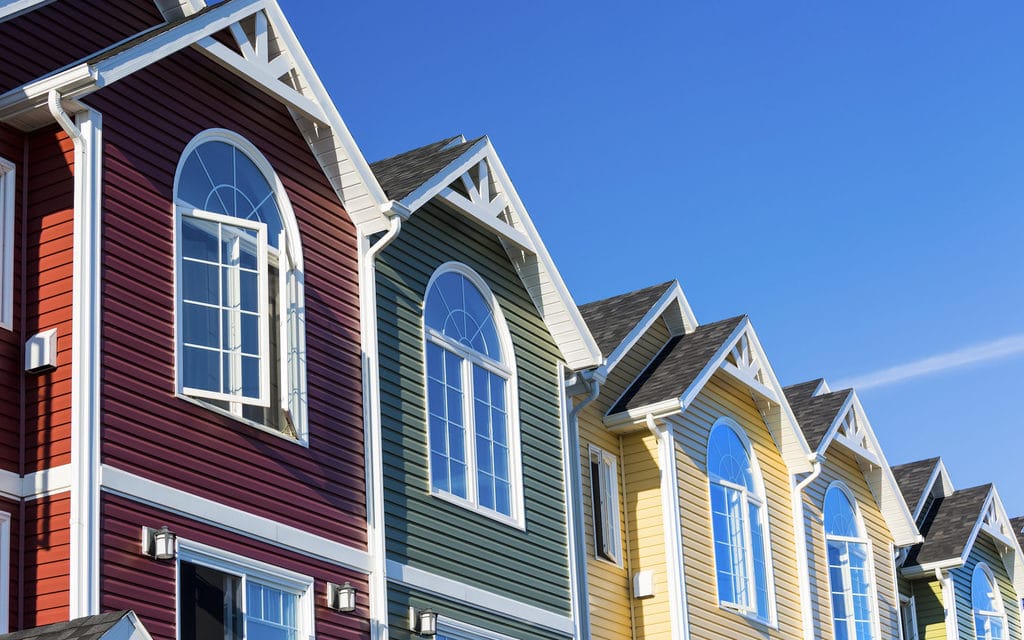To make house exteriors weatherproof but also achieve an aesthetic finish, Vinyl Siding is often use. It is a common type of finish used in Countries like the United States and in parts of Europe. It is used where houses are built of wood or plasterboard and need an additional layer of protection without reducing the level of aesthetics. Let’s see how to paint vinyl siding.
Essentially, Vinyl Siding is a type of Exterior finish made of a plastic compound that is used in residential and apartment buildings. The siding imitates wooden battens or wooden clapboards. It also replaces the use of materials like aluminium and fibre cement siding. Vinyl Siding is engineer from a type of polyvinyl chloride resin or PVC.
As resilient as vinyl siding is, it does tend to wear over time and requires some basic maintenance. Sun exposure causes it to fade but it can, fortunately, be painted over to achieve a brand-new and untainted look.
From a layman’s perspective, the easiest thing to do would be to replace the vinyl siding completely when it starts to wear out. But construction experts say that painting it rather than replacing it is the best option.
So in this article on how to paint vinyl siding, its advantages and considerations are mentioned. This can give you a deep insight into the vinyl siding and its various processes.
How to Paint Vinyl Siding at Ease

The question of how to paint vinyl siding has an easy solution but can only be achieved with some care and consideration. Painting vinyl siding is not necessarily a difficult task and also does not exclusively need skilled labour to do.
Can one paint vinyl sidings on their own? Of course, they can! But To paint vinyl siding, the person must be aware of specific parameters that would optimise the work and give a great finish.
- Good Weather
- Good Surface
- Appropriate Paint
- Primer
5 Effective Steps on How to Paint Vinyl Siding
Step 1: Check for the Weather
Painting must be done only in pleasant weather. Rain, humidity and wind can affect the application of the paint. Painting in unfavourable conditions of weather could lead to the improper application of paints that may not stick.
Step 2: Cleaning the Vinyl Siding Surface

The surface of the pre-existing vinyl siding must be clean thoroughly before applying paint. Painting on uneven surfaces may create ridges and lumps where the paint can collect. Removing mould, mildew, grime buildup and dust is also essential to ensure that the surface is clean. To clean the surface some methods call for 30% vinegar and 70% water which is capable of removing mild stains. To clean larger dirt and grime build-up, a mixture of laundry detergent, bleach, water and floor cleaners might also do the trick.
The easiest way to clean vinyl sidings is through pressure washing where one must make sure they do not get water near openings like doors, windows or ducts.
Any paint peeling or chipping on the sidings must be sand thoroughly to achieve an even surface before painting.
Step 3: Masking
Masking off edges of doors, windows, walls etc with masking tape or sheet is essential to ensure the paint won’t get into areas where one does not want it.
Step 4: Applying the Paint
Normal wall paint cannot be use on vinyl siding as the surface is essentially made of plastic. So the common question that arises in people’s minds is “Can Paint stick to a Vinyl Surface?” While normal paints cannot, Latex urethane and other types of acrylic resins are the best for painting vinyl sidings. These types of resins are accommodating of their thermal expansion.
Application of paint should be done in coats or according to the manufacturing instruction that may come with paint. Paint should be apply evenly across the surface and after the first coat must be allowed to dry completely. A second coat can be add after that. Paint can be apply either with a brush or roller, as for a common person painting, controlling the application and finish of a spray may be difficult.
Step 5: Primer

Primer can be apply before or after painting and is usually apply as a protective layer. The primer can be apply with a brush or spray.
Considerations While Painting Vinyl Siding
While painting vinyl sidings may seem like the best option, there are some things one should consider before proceeding.
1. Cost
As mentioned earlier, painting vinyl siding is much more cost-effective than replacing it. However, it can only be replaced if the entire siding is still in a good condition i.e without breaks, cracks or holes. The cost of painting is estimate to be around $99 – $242 per 300 square feet. The cost of replacing the siding is estimated at $5000 – $14000.
2. Home Value
To those who plan on staying in the same house for a long time, painting vinyl siding is a good investment. Since painting gives the feel of a newer and brighter look, homeowners tend to lean towards that. However, for a person who may not reside in the house for too long, painting is unnecessary and is a waste.
3. Warranty
Vinyl Sidings usually come with a warranty provided by the company that manufactures them. Painting over them may cancel the warranty available on it. In any unforeseen cases of damages, not having a warranty could be disadvantageous.
While some manufactures do provide warranties after painting, it is best to check with the manufacturer before proceeding. One must also check if the vinyl siding is include in the insurance claim of the home.
4. Integrity of Siding
One must understand that the siding is the outermost protective layer of the house and protects the walls from weather, wear, dust etc. Sidings are bound to get damage over time and simply painting over them may not be feasible in the long run.
This is because painting over worn-out sidings does not cover its damage. continuously painting over old vinyl sidings also reduces its protective capacity.
5. Colour
Vinyl Siding does not come in many different colours and are available in a few shades. If one wants a more unique colour to their siding, the painting would be a better alternative. Usually darker colours tend to absorb more heat and lighter colours are more reflective.
Hence the appropriate colours can be use according to the location and desire amount of absorption/ reflectivity.

6. Insulation
Adding an insulation layer behind the vinyl siding will help in reducing the amount of energy used in heating/ cooling. Newer Vinyl Sidings come with a layer of insulation.
Hence, replacing them gives an added advantage of insulating the home while painting does not.
7. Thermal Expansion
Vinyl sidings have a tendency to expand during summers and also have the capability of being disfigure if the temperatures become too hot.
8. Time
Professional painting over vinyl siding is much less time consuming than painting it oneself.

Replacing Vinyl Siding vs. Painting Vinyl Siding
Painting vinyl siding can last up to 5 years after which it may start fading again. Replacing it is much more longer-lasting, with an average of 30 years depending on the manufacture.
However, the larger the home, the larger the cost of replacing the Vinyl Siding surface. Expenses like installation fees, scaffolding, equipment, labour fees and amount of work will take into account while calculating the total cost of the work.
Painting vinyl siding increases the value of the house without increasing the cost. Regular home maintenance is important to make sure the house does not get devalued over time. Painting over it is much less labour intensive than painting over wood, masonry or hardboard. Since the siding is moisture repulsive, it is much easier to clean than other exterior cladding.
Conclusion
Although replacing vinyl siding is considered a good option when it comes to siding maintenance, painting it has a large set of advantages as well. At the end of the day, things like cost, appearance and time are the three most important factors that a homeowner would consider and paint vinyl siding is advantageous to intend all three aspects. It is possible to paint vinyl sidings and has been done by many people, skilled or unskilled.
As long as one considers all the nuances of it, they can proceed confidently in giving it a fresh coat of paint and making their house look as good as new!
For more information:-

